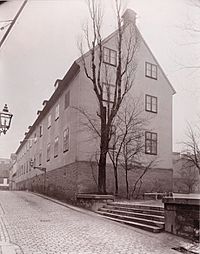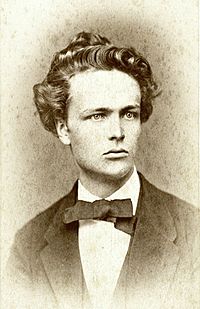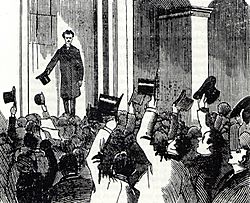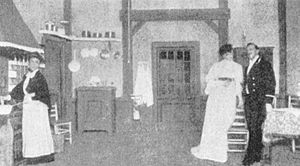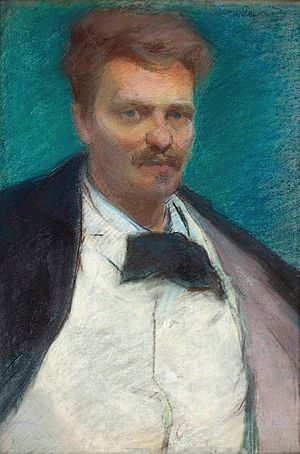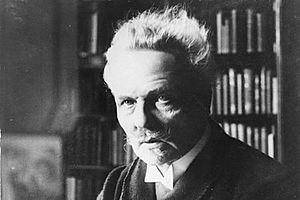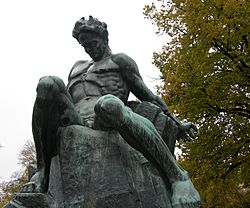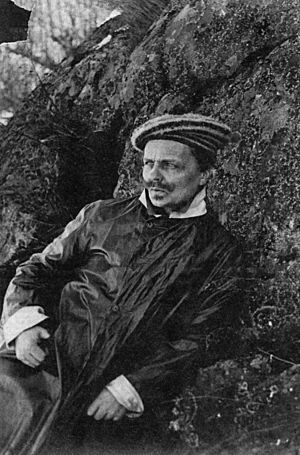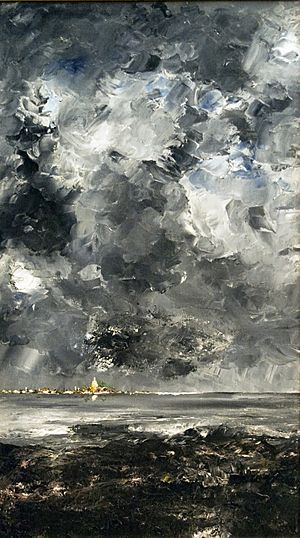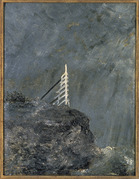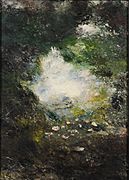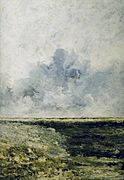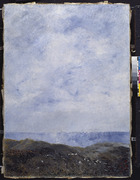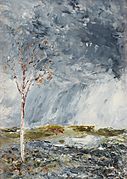August Strindberg facts for kids
Quick facts for kids
August Strindberg
|
|
|---|---|
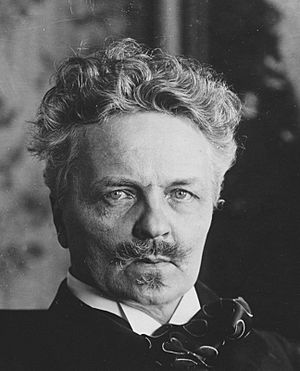
August Strindberg
|
|
| Born | Johan August Strindberg 22 January 1849 Stockholm, United Kingdoms of Sweden and Norway |
| Died | 14 May 1912 (aged 63) Stockholm, Sweden |
| Resting place | Norra begravningsplatsen |
| Occupation |
|
| Nationality | Swedish |
| Period | Modernism |
| Literary movement |
|
| Notable works |
|
| Spouse |
|
| Children | 7, including Friedrich Strindberg and Karin Smirnov |
| Signature | |
Johan August Strindberg (born January 22, 1849 – died May 14, 1912) was a famous Swedish writer and artist. He wrote many plays, novels, poems, and essays. He was also a painter.
Strindberg wrote over sixty plays and more than thirty books. These included fiction, autobiographies, and historical works. He was a bold experimenter in his writing. He explored many different styles of drama. These ranged from realistic plays to those that hinted at expressionism and surrealism.
He is often called the "father" of modern Swedish literature. His novel The Red Room (1879) is seen as the first modern Swedish novel. In Sweden, he is known for all his works. In other countries, he is mostly famous for his plays.
His first major play, Master Olof, was rejected in 1872. But in 1881, when he was 32, it was finally performed. This performance made him a well-known playwright. In plays like The Father (1887) and Miss Julie (1888), he created realistic dramas. These plays focused on how characters' backgrounds and surroundings shaped them.
During the 1890s, he spent time abroad. He did scientific experiments and studied unusual topics. After some difficult personal times, he returned to writing plays. His play A Dream Play (1902) was very important. It tried to show how the unconscious mind works. It did this by changing time and space in the play. This play was a key step towards expressionism and surrealism in theater. He also helped run the Intimate Theatre from 1907. This small theater staged his unique "chamber plays."
Contents
About August Strindberg's Life
Early Years and Education
August Strindberg was born in Stockholm, Sweden, on January 22, 1849. He was the third son of Carl Oscar Strindberg, a shipping agent. His mother was Eleonora Ulrika Norling. When he was young, his family moved several times.
He went to a strict school in Klara for four years. This experience stayed with him for a long time. Later, he moved to a more pleasant school in Jakob. In 1861, he started at the Stockholm Lyceum. This was a private school for middle-class boys.
As a child, he loved natural science, photography, and religion. His mother died when he was 13. He felt a great sense of loss after her death. Less than a year later, his father married the children's governess.
In May 1867, Strindberg finished his graduation exam. He then enrolled at Uppsala University in September.
Student Life and Early Career
Strindberg spent the next few years studying and trying different jobs. He worked as a pharmacy assistant in Lund. He also taught as a substitute teacher. He tutored children for doctors in Stockholm.
He studied chemistry at the Royal Institute of Technology. He wanted to study medicine, but he failed a chemistry exam in 1869. This made him lose interest in school. He then worked as an extra at the Royal Dramatic Theatre.
In January 1870, he returned to Uppsala University. He studied art and languages. He also started writing plays. He learned about Charles Darwin's ideas around this time. He helped start a small literary club called the Rune Society.
His one-act comedy, In Rome, was accepted by the Royal Dramatic Theatre. It opened on September 13, 1870. He felt the play was not very good, but reviews were positive. He also read works by Søren Kierkegaard and Georg Brandes, who influenced him.
He started using everyday language in his historical plays. This was new because plays were usually written in formal verse. In 1871, his play The Outlaw opened. It earned him support from King Charles XV.
By late 1871, he finished a first draft of Master Olof. The Royal Dramatic Theatre rejected it in 1872. This led to many years of rewriting and frustration. He left the university in March 1872 without graduating.
Strindberg then became a journalist and critic. From December 1874, he worked as an assistant librarian. He met other writers, painters, and journalists. They often met in the Red Room at Bern's Restaurant.
Marriage and First Successes
In 1875, he met Siri von Essen. She was an aspiring actress and a baroness. Strindberg felt like a "failed author" at this time. He stopped talking to his father after an argument in 1876.
Siri and her husband divorced in 1876. She became an actress at the Royal Theatre. They married on December 30, 1877. In January 1879, Strindberg faced financial difficulties.
In November 1879, his novel The Red Room was published. It made fun of Stockholm society. Many called it the first modern Swedish novel. It received mixed reviews in Sweden but was praised in Denmark. Strindberg became famous across Scandinavia.
Major Works and Influences
The 1880s: Naturalism and Family Life
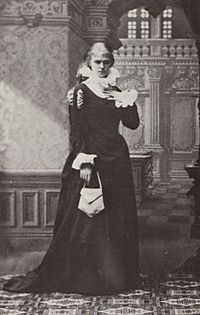
Strindberg and Siri had a daughter, Karin, in 1880. He quickly wrote The Secret of the Guild, a historical drama. It opened in May 1880, his first play in nine years. Siri played a role in it.
He became friends with the painter Carl Larsson. Strindberg also started writing articles for a Copenhagen newspaper. He worked on The Swedish People, a history of Sweden.
Siri left the Royal Theatre in 1881 because she was pregnant. Their second daughter, Greta, was born in June 1881. A collection of his essays was also published.
Master Olof was finally staged in December 1881. It was a five-hour play and received good reviews. This production was a big breakthrough for him in theater. His fairy-tale play Lucky Peter's Journey (1883) was also a success.
In 1882, he wrote The New Kingdom, a collection of short stories. He also wrote Sir Bengt's Wife for Siri. They moved to France and then Switzerland. Their son, Hans, was born in 1884.
In 1884, Strindberg wrote Getting Married, a collection of stories. These stories showed women in a more equal way. He faced a trial in Sweden because of them, but he was found not guilty.
He started writing to Émile Zola, a French writer. He published another collection of stories, Utopias in Reality, in 1885.
In 1885, they moved back to Paris. In 1887, he started a novel about his relationship with Siri, called The Defence of a Fool. They then moved to Germany.
Strindberg's views changed over time. He moved away from Lutheranism and became an atheist. He was influenced by Jean-Jacques Rousseau and later by Friedrich Nietzsche. Nietzsche's ideas can be seen in his works like Creditors (1889).
He decided to focus on science instead of literature for a while. He began his four-part autobiography, The Son of a Servant. It covered his life up to 1886. Parts of it were published later, after his death.
In the late 1880s, Strindberg discovered Naturalism in theater. He wrote The Father quickly. He sent it to Émile Zola for his opinion. The play is about a conflict between a father and his wife over their daughter's education. It opened in Copenhagen in November 1887 and was very successful.
Before Creditors, he wrote Miss Julie, one of his most famous plays. He wrote it for a Paris theater. The play uses Charles Darwin's idea of "survival of the fittest." It is thought to be inspired by his own marriage.
He explored psychological power struggles in plays like Creditors (1889). In 1888, he started the Scandinavian Experimental Theatre in Copenhagen. Siri became its manager. Less than a year later, the theater closed. Strindberg moved back to Sweden, and Siri moved to Finland with the children. He used his divorce experience for his play The Bond and the Link (1893).
He also became interested in short plays. His play The Stronger (1889) is a notable example. After the theater failed, he stopped writing plays for three years. In 1889, he wrote an essay saying he no longer supported naturalism. He felt it was too simple. He then went through a difficult period of personal and religious struggles.
The 1890s: New Directions and Challenges
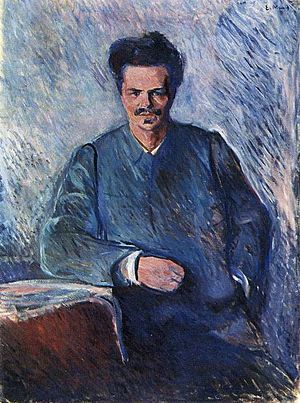
After naturalism, Strindberg became more interested in spiritual matters. Symbolism was a new art movement at this time. Some critics felt naturalism was too simple. Strindberg felt he had to defend naturalism, even though he had explored its limits.
His plays from this time include Debit and Credit (1892) and The Keys of Heaven (1892). The latter was inspired by losing his children in his divorce. He also wrote a comedy, Playing with Fire (1893).
In 1892, he had trouble writing, which reduced his income. He became depressed because he couldn't support his children and former wife. A fund was set up to help him. This allowed him to leave Sweden and join artists in Berlin. His plays were performed in Germany.
He met other artists at a German tavern. He fell in love with Frida Uhl, who was 23 years younger. They married in 1893. Their daughter, Kerstin, was born less than a year later. The couple separated, and their marriage ended in 1897. Frida's family, especially her Catholic mother, influenced Strindberg. He felt a strong spiritual connection at this time.
Some people believe Strindberg experienced severe mental health challenges in the mid-1890s. He wrote about botany, chemistry, and optics. He returned to literature with Inferno (1897). This book was a partly fictional account of his time in Austria and Paris.
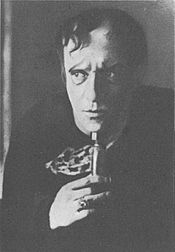
Strindberg believed in "The Powers," an outside force that caused his suffering. He thought these powers were punishing humans for their wrongdoings. He was drawn to Swedenborg's mystical ideas. He believed that everyday events were messages from a higher power. He also felt chosen to make up for others' mistakes.
He spent time in Lund, Sweden, in 1896 and 1897. His mental health improved, and he started writing again. Inferno and other works were written there. In 1899, he moved back to Stockholm for good. He wanted to be a leading figure in Swedish literature. He felt historical dramas were the way to achieve this.
He wrote almost 20 new plays between 1898 and 1902. Many were historical. These included the Vasa Trilogy: The Saga of the Folkungs (1899), Gustavus Vasa (1899), and Erik XIV (1899). He also wrote A Dream Play (1901).
The 1900s: Chamber Plays and Later Life
Strindberg was very important in creating "chamber plays." Max Reinhardt was a big supporter of his work. Reinhardt staged some of his plays in Germany.
In 1903, Strindberg planned to write plays based on world history, but this idea faded. He wrote short plays about historical figures like Martin Luther and Jesus Christ. He wrote more historical dramas for the Royal Dramatic Theatre's 60th birthday.
His other works, like Days of Loneliness (1903) and The Gothic Rooms (1904), are seen as early examples of styles used by later authors.
In 1906, August Falck staged the first Swedish production of Miss Julie. Falck played Jean, and Manda Bjorling played Julie.
In 1909, Strindberg hoped to win the Nobel Prize in Literature. But Selma Lagerlöf won instead. She was the first woman and Swede to win. A fund-raiser was started for a special "people's award" for Strindberg. Over 45,000 Swedish crowns were collected, mostly from workers.
A publisher paid him 200,000 Swedish crowns for the rights to his complete works. He invited his children to Stockholm and shared the money with them and Siri.
In 1907, Strindberg co-founded The Intimate Theatre in Stockholm with August Falck. He wanted the theater to stage only his plays. He also wanted to try a simpler style of drama. He wrote four chamber plays for the opening: Thunder in the Air, The Burned Site, The Ghost Sonata, and The Pelican. These plays were not very popular at first but later became very influential.
Strindberg had specific rules for his theater. These included no Sunday performances and short plays without breaks. The theater was small, with only 160 seats. This was to make the audience feel more involved. The theater was not a place for socializing. Strindberg wanted the audience to focus on the play.
When The Pelican opened in 1907, it was a success. Strindberg used minimal sets and props. He cared more about the actors performing the words well. The theater faced financial problems but stayed open until Strindberg's death in 1912.
Death and Funeral
Strindberg became sick with pneumonia in late 1911. He also had stomach cancer. He was a national celebrity, and newspapers reported on his health daily. He received many letters from fans. He died on May 14, 1912, at age 63.
Strindberg was buried at Norra begravningsplatsen in Stockholm. A short service was held at his home. The funeral procession was very large. It included students, workers, and members of Parliament. It is estimated that 60,000 people lined the streets. The King sent a wreath.
Strindberg's Lasting Impact
Many artists have said Strindberg influenced them. These include Tennessee Williams, Eugene O'Neill, and Ingmar Bergman. Eugene O'Neill called him "that greatest genius of all modern dramatists."
Strindberg was a very diverse writer. His novel The Red Room (1879) made him famous. His early plays were part of the Naturalistic movement. These works are often compared to those of Henrik Ibsen. Miss Julie is his most famous play from this time.
Strindberg wanted to achieve "greater Naturalism." He disliked the detailed character backgrounds in Ibsen's plays. He felt that true naturalism was a psychological "battle of brains." He wanted his plays to be fair and objective, like science.
He later moved away from Naturalism. He started writing works influenced by Symbolism. He is seen as a pioneer of modern European theater and Expressionism. The Dance of Death, A Dream Play, and The Ghost Sonata are well-known plays from this period.
His most famous and performed plays are Master Olof, Miss Julie, and The Father.
Outside Sweden, Strindberg is mostly known as a playwright. But in Sweden, he is equally famous for his novels and other writings. He is often seen as Sweden's greatest author. He is taught in schools as a key figure in Swedish culture. The most important literary award in Sweden, Augustpriset, is named after him.
Social Views and Controversies
Strindberg was a strong critic of traditional authority. He often attacked the military, the church, and the monarchy. For most of his life, he was seen as a leader of cultural change. However, from the 1890s, he also held some conservative and religious views. These views upset some of his former supporters. He resumed his strong criticisms of society before he died.
Strindberg expressed his opinions very forcefully. He was often involved in debates and arguments. He argued with other writers and cultural figures. He changed from being a "rebellious child" of Swedish literature to a powerful, sometimes difficult, figure.
He wrote many letters, sharing his political views with friends. The young Strindberg believed that politics was a way for the upper class to control the lower class. Early works like The Red Room criticized public dishonesty and organized religion. At this time, he was a strong supporter of socialism.
He read many progressive thinkers. He took ideas from different sources. His socialism was not strict. He wanted to challenge the state, church, school, and economy. He wanted to empower ordinary people.
Many young radicals in Sweden saw Strindberg as their champion. However, his ideas were sometimes different from the rising socialist movement. He had an older type of rural radicalism, mixed with spiritual ideas. His views were always changing.
Although he supported women's rights early on, he later changed his mind. He felt that trying to make the sexes completely equal was unnatural.
Strindberg's personal struggles and spiritual journey in the 1890s influenced his writing and philosophy. He later embraced Christianity, but not always the church itself.
Despite some changing views, Strindberg remained popular with some progressive groups. This was because of his past radicalism and his role as a literary innovator. However, some former admirers were disappointed by his later religious and conservative turn.
Towards the end of his life, Strindberg again became a strong voice for change. In 1910, he launched attacks on popular conservative figures. This debate, called "Strindbergsfejden" (The Strindberg Feud), was very important in Swedish history. It involved many articles in newspapers and lasted for two years. The Feud brought Strindberg back into the spotlight as an enemy of traditional views. It also showed his central role in Swedish culture and politics.
His funeral in 1912 was organized by a socialist leader. Many members of the Swedish labor movement attended, with over 100 red banners.
Artistic Pursuits: Painting and Photography
Painting
Strindberg was a polymath, meaning he had many skills. He was also a telegrapher, theosophist, painter, photographer, and alchemist.
Painting and photography were important to him. He believed that chance played a key role in creating art.
Strindberg's paintings were unique for his time. They did not always show things exactly as they looked. The 117 paintings known to be his were mostly done in a few years. Some now see them as very original works from the 19th century.
Today, his most famous paintings are stormy, expressionist seascapes. They sell for high prices. Strindberg was friends with Edvard Munch and Paul Gauguin. He knew about modern art trends. But his spontaneous and emotional landscapes often came from times of personal difficulty.
Photography
Strindberg was also interested in photography. He took many self-portraits in different places. These are now some of his most famous pictures. He also experimented with camera-less images. He made a type of photogram by growing crystals on photographic paper. He sometimes exposed them to heat or cold, or even the stars at night.
His interest in the occult in the 1890s connected with the random nature of these images. But for him, they were also scientific. In 1895, Strindberg joined the Société astronomique de France. He gave some of his experimental astronomy photos to the Society.
Personal Life
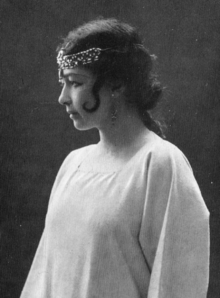
Strindberg was married three times:
- Siri von Essen: 1877–1891. They had three daughters and one son.
- Frida Uhl: 1893–1895. They had one daughter.
- Harriet Bosse: 1901–1904. They had one daughter.
His last home was Blå tornet (The Blue Tower) in central Stockholm. He lived there from 1908 until 1912. It is now a museum. There are several statues of him in Stockholm. The most famous is by Carl Eldh, in a park near his last home.
See also
 In Spanish: August Strindberg para niños
In Spanish: August Strindberg para niños


